I cannot understand what I'm doing wrong. I want to group items in listView. In result I want to see something like that:

It'm using MVVM pattern. It's my XAML code.
<CollectionViewSource x:Key="EmploeeGroup"
Source="{Binding Path=AllEmploees}">
<CollectionViewSource.GroupDescriptions>
<PropertyGroupDescription PropertyName="FirstName" />
</CollectionViewSource.GroupDescriptions>
</CollectionViewSource>
<ListView AlternationCount="2"
DataContext="{StaticResource EmploeeGroup}"
ItemsSource="{Binding IsAsync=True}" Padding="0,0,0,10">
<ListView.GroupStyle>
<GroupStyle>
<GroupStyle.ContainerStyle>
<Style TargetType="{x:Type GroupItem}">
<Setter Property="Margin" Value="0,0,0,5"/>
<Setter Property="开发者_如何学运维Template">
<Setter.Value>
<ControlTemplate TargetType="{x:Type GroupItem}">
<Expander IsExpanded="True" BorderBrush="#FFA4B97F"
BorderThickness="0,0,0,1">
<Expander.Header>
<DockPanel>
<TextBlock FontWeight="Bold"
Text="Name: "/>
<TextBlock FontWeight="Bold"
Text="{Binding Path=FirstName}"/>
</DockPanel>
</Expander.Header>
<Expander.Content>
<ItemsPresenter />
</Expander.Content>
</Expander>
</ControlTemplate>
</Setter.Value>
</Setter>
</Style>
</GroupStyle.ContainerStyle>
</GroupStyle>
</ListView.GroupStyle>
<ListView.View>
<GridView>
<GridViewColumn Width="150"
Header="FirstName"
DisplayMemberBinding="{Binding Path=FirstName}"/>
<GridViewColumn Width="150"
Header="LastName"
DisplayMemberBinding="{Binding Path=LastName}"/>
</GridView>
</ListView.View>
</ListView>
It's my EmploeeListViewModel.cs
public class EmploeeListViewModel: ViewModelBase
{
readonly EmploeeRepository _emploeeRepository;
private ObservableCollection<EmploeeViewModel> _allmpl;
public ObservableCollection<EmploeeViewModel> AllEmploees
{
get
{
if (_allmpl == null)
{
_allmpl = new ObservableCollection<EmploeeViewModel>();
CreateAllEmploee();
}
return _allmpl;
}
}
public EmploeeListViewModel(EmploeeRepository emploeeRepository)
{
if (emploeeRepository == null)
throw new ArgumentNullException("emploeeRepository");
_emploeeRepository = emploeeRepository;
_emploeeRepository.EmploeeAdded += this.OnEmploeeAddedToRepository;
}
private void CreateAllEmploee()
{
List<EmploeeViewModel> all =
(from emploee in _emploeeRepository.GetEmploees()
select new EmploeeViewModel(emploee)).ToList();
foreach (EmploeeViewModel evm in all)
{
evm.PropertyChanged += this.OnEmploeeViewModelPropertyChanged;
AllEmploees.Add(evm);
}
this.AllEmploees.CollectionChanged += this.OnCollectionChanged;
}
//this.OnCollectionChanged;
//this.OnEmploeeViewModelPropertyChanged;
}
EmploeeViewModel.cs
public class EmploeeViewModel : ViewModelBase
{
#region Fields
Emploee _emploee;
bool _isSelected;
#endregion
#region Constructor
public EmploeeViewModel(Emploee emploee)
{
if (emploee == null)
throw new ArgumentNullException("emploee");
this._emploee = emploee;
}
#endregion
#region Emploee Properties
public bool IsSelected
{
get { return _isSelected; }
set
{
if (value == _isSelected)
return;
_isSelected = value;
base.OnPropertyChanged("IsSelected");
}
}
public string FirstName
{
get { return _emploee.FirstName; }
set
{
if (value == _emploee.FirstName)
return;
_emploee.FirstName = value;
base.OnPropertyChanged("FirstName");
}
}
public string LastName
{
get { return _emploee.LastName; }
set
{
if (value == _emploee.LastName)
return;
_emploee.LastName = value;
base.OnPropertyChanged("LastName");
}
}
#endregion
}
- Why can not I bind "FirstName" property with Expander.Header TextBlock?
- Why have I object type MS.Internal.Data.CollectionViewGroupInternal inside Expander.Header(if i wrote inside Expander.Header Text="{Binding}")>?
How should I change my XAML or .CS code to produce these results?
I found answer on this question by myself.
The object that is sent into the converter is of the type: MS.Internal.Data.CollectionViewGroupInternal.
The main reason is to use "Name" for databinding the group names is simply because that is the property in CollectionViewGroupInternal that contains the name that the current "group collection" has (according to the GroupDescription that you specified).
Not important What was GropertyName in PropertyGroupDescription. You have to always use {Binding Path=Name} in GroupStyle container.
I had to change only one string in my XAML.
From:
<TextBlock FontWeight="Bold" Text="{Binding Path=FirstName}"/>
To:
<TextBlock FontWeight="Bold" Text="{Binding Path=Name}"/>
Just came across the same Problem regarding the "Name / FirstName" Binding-Problem and found a solution for my project here: Grouping ListView WPF
In short, withing the Expander-Tag you can set the DataContext to "{Binding Items}". After that you can use your original property names.





![Interactive visualization of a graph in python [closed]](https://www.devze.com/res/2023/04-10/09/92d32fe8c0d22fb96bd6f6e8b7d1f457.gif)



 加载中,请稍侯......
加载中,请稍侯......
精彩评论